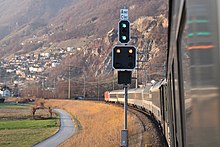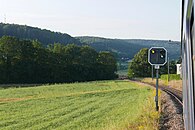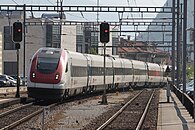Signal system L
The signal system L is a railway light signal system in Switzerland. It differentiates between pre- and main signals . The designation was introduced after 1986 to distinguish the old signal system from the signal system N and the mechanical signal system M, which was introduced that year . L stands for light signal.
The announcement and execution of a speed are shown with colored light point combinations. The system knows three colors: green, fire yellow and red. The signal color red is always used alone as a stop signal.
Signal aspects
| Distant signal | Main signal | Driving term | meaning | |||
|---|---|---|---|---|---|---|
| Route signaling | Speed signaling | |||||
 until January 31, 1935 |
 from January 31, 1935 |
 |
Advance signal: stop at the main signal. Main signal: stop |
|||
 until January 31, 1935 |
 from January 31, 1935 |
 |
Free travel without specifying points or speed limits | |||

|

|
1 | Free travel, switches in a straight position or switch-free section | Free travel, speed not framed or circled in the duty timetable | ||
 |
 until October 6, 1940 |
 from October 6, 1940 |
2 | Free travel, deflecting points, normal radius | Free travel, 40 km / h (possibly lower speed according to the duty schedule ) | |

|

|
3 | Free travel, deflecting points, large radius | Free travel, speed framed or circled in the duty timetable (between 50 and 85 km / h) | ||
 |
 disappeared |
4th | Free travel, closer turnouts straight, distant ones distracting, normal radius | Free travel, speed gradation up to 40 km / h (or less) according to the duty timetable and the appendix to the driving regulations | ||
 until October 31, 1967 |
 from 1.11.1967 |
 |
5 | until 31.10.1967: Free travel, closer points straight, distant ones distracting, large radius (never used) |
from 1.11.1967: Free travel, speed 95 or 90 km / h, circled in the duty timetable |
|

|

|
6th | Free travel, next main signal shows stop If at the entry signal : 40 km / h from the entry point If at the track section signal : 40 km / h from now on |
|||
| Source: | ||||||
Designs
 |

|
| without... | With... |
| ... blanking of the distant signal | |
Main and distant signals on the same mast

On the mast of the entry signal there is usually also the exit pre-signal . In the case of short distances between stations - if the distance between the exit and entry signals corresponds approximately to the distance from the distant signal - the entry distant signal of the next station appears under the main signal.
A distant signal under a main signal indicating a stop never shows a driving concept . It either signals a warning or remains dark. On most private railways , the distant signal is switched off normally. At the SBB , the distant signal is usually switched off for exit signals and three or more adjacent entry signals.
Missing signals
 |

|
| Marks in the FDV |
Marks at the GFM |
If there were no distant signals, a notice board was set up to announce an entry signal without distant signal . The mark only appeared on a few secondary lines , but is still listed in the driving service regulations (FDV). The board is set up in the braking distance from the entry signal and has the function of a warning signal.
There is also the notice board S for a missing entry signal. This black S on a white, round board is placed at a braking distance from the first switch.
Supplementary signals
The auxiliary signal is used when a main signal on the same mast cannot be set to travel, e.g. B. because of a mistake or because of construction work. The brand-yellow, inclined row of lights allows the vehicle to pass the main signal that is indicating a stop or that has been extinguished at reduced speed.
The busy signal under an entry or track section signal announces that an obstacle is to be expected on the following track section.
 |

|
| Speed threshold |
Response of the train protection |

|
Track number signal |
 |

|
| Auxiliary signal | Busy signal |
In the signal system L, the speed limit signaled on the entry signal only applied from the first switch. In 1998 this rule was changed and adapted to the signal system N , where the speed limit must be observed from the signal. In some train stations this would have resulted in too high a loss of travel time due to the local conditions. In these stations, the previous rule continues to apply, which is indicated by the notice board for the speed threshold for signal system L at the approach signal. In railway jargon , the bulletin board is referred to as a tuning fork, elk or deer antler.
If a train is not supposed to enter the planned track at a station, the engine driver at a stopping station behind must be notified in writing. Alternatively, this communication can also take place via a track number signal at the entry signal. Since 1957, this communication can be omitted in certain train stations, which are marked with a black triangle in the duty timetable. A triangular sign on the last catenary mast in front of the approach signal or directly at the approach signal indicates that the train protection also responds in the event of a distracting entrance. The official name of the sign reads Marks for entry to the offered track with activation of the train protection in the event of a distracting entrance . The mark is no longer used in new systems, as train protection nowadays also applies to restrictive driving terms.
Repetitive signals
If there is insufficient visibility of the main signal, repeat signals are set up. Ordinary light pre-signals are used for this.
Special designs
| Stop | |
| Free travel at 40 km / h |

|
| under a platform roof |

|
| with a wide table |
The increasing number of lights on main signals resulted in longer and longer panels. This is why main signals with widened boards have been used since 1967. In the case of the widened main signals, the lamps for red and "emergency red" are moved to the right column. If there is a lack of space, for example under platform roofs, other board shapes are available.
In freight and shunting systems with a maximum speed of 40 km / h, so-called mini-main signals can be used instead of normal main signals. These are mounted close to the ground - in systems with dwarf signals directly on a dwarf signal.
Block signals

| profile | Possible terms | |||||
|---|---|---|---|---|---|---|

|

|

|

|
with noticeably signs |
||

|

|
 |
without noticeably signs |
|||

|

|

|

|
|||
| Source: | ||||||
Ordinary light signals are normally used as block signals for subdividing long station sections. On some routes with particularly short block sections , the two fire-yellow pre-signal lights are combined with the green and red light of the main signal and the light for “emergency stop” in a square board. Additional lights can also be used to display additional driving terms.
Block signals that can indicate a stop are provided with a special marker. If the signal goes out, you must stop before it. In the case of block signals without a marker, the term warning must be assumed when the signal is extinguished .
history
1930s
| Signal aspect | meaning |
|---|---|
 |
Stop at the main signal |
 |
Free travel, switches in a straight position or switch-free section |
 |
Free travel, deflecting points , normal radius |
In difficult lighting conditions, mechanical signals are often difficult to see. Thanks to lenses instead of colored disks , light signals can also be seen during the day and allow the maintenance-intensive wire pulls to be dispensed with. In 1930 the SBB set up a pilot light in Vaumarcus as an experiment . In 1932, for comparison purposes, Winterthur was equipped with light signals of the Westinghouse design and Chur with light signals from Signum . This marked the beginning of the era of light signals. From 1939, only light signals were used for new installations.
In the 1930s there were plans to increase the speed of the line in many places, which necessitated an increase in the distance between the distant signals. The use of light pre-signals avoided the difficult operation of mechanical pre-signals due to the greater distance. At the same time, the opportunity was used to create an additional distant signal concept, driving over distracting points . Drive- through signals were also preferably replaced by light pre-signals, as, in contrast to the former, they can announce the exact position of the exit signal . In the 1947 regulations, they were consequently called exit pre-signals.
In front of two-aspect main signals , behind which journeys in a distracting position are also possible, the light pre-signal, analogous to the mechanical pre-signal, shows two horizontally arranged green lights as a driving concept at night. The first three-aspect light pre-signals had six lamps that were simply connected in pairs in series .
1940s
| until 1940 | from 1940 |
|---|---|

|

|
By October 6, 1940, the lower green light on all main signals was replaced by fire yellow. Driving over distracting points ( driving concept 2 ) has since been signaled with the light combination green / fire yellow. In the case of the three-wing semaphores, only the middle colored disk was exchanged, so that with three wings in the driving position it showed green / fire yellow / green as a night signal. The combination of green / green was used for the new driving concept of driving over distracting points with a large radius (driving concept 3).
→ see also the section on changing the signal colors in the signaling system M article
| Signal aspect | meaning |
|---|---|
| Stop | |
| Warning, stop at the next signal |
|
| Free ride |
Speed restrictions due to distracting points always had to be observed from the first point behind the main signal. In the event that initially only switches in a straight position and only further away switches in a distracting position were to be used, driving terms 4 and 5 were created on an experimental basis . Driving concept 4 remained a rarity and driving concept 5 should never have been used anywhere. They were abolished in 1967.
In 1941, automatic block signals were installed between Zurich HB and Oerlikon , which, in addition to stopping and driving, could also display the warning signal . This reduced the number of light points per signal. These combined signals had a screen that differed from the later versions. These block signals disappeared towards the end of the 1960s.
The signaling regulations from 1947 replaced those from 1916. It introduced track signals for the exit, so that each track received its own exit signal instead of the group signals that were common in the past . The latter are still used in simple circumstances. As already mentioned, the light pre-signals on the entry signal have been referred to as exit pre-signals instead of drive-through signals since 1947, and the block signals introduced in 1936 have been included in the regulations.
Further developments
| until 1967 | from 1967 |
|---|---|

|

|
In 1957 the track section signal was introduced to subdivide station tracks into several sections and with it the new driving term 6 .
In 1967 speed signaling was introduced. The main signal only shows the permitted speed. This enables new applications, as speeds can be signaled independently of switch positions. For example, an exit signal for a short station distance and a closed entry signal for the neighboring station can indicate slow travel. The previous driving term 4 has been abolished. The term 5 is redefined to mean free travel at 90/95 km / h . Since distant signal term 5 did not differ clearly enough from term 1 from a greater distance, the fire-yellow light was shifted from top left to bottom right.
In the course of time, the provisions of the signal system L were partially adapted to the system N introduced in 1986 . The speed threshold will be moved from the first switch to the entry signal and the 5 km / h higher speeds for trains in the R series for driving terms 3 (60/65 km / h) and 5 (90/95 km / h) will be abolished.
photos
Covered lamp at the bottom left because driving term 1 is not used.
Individual evidence
- ^ A b Rudolf W. Butz: Signals of the Swiss Railways . Orell Füssli Verlag, Zurich 1972, p. 21 .
- ↑ a b c d e Roland Smiderkal: Signals in Switzerland. Signal system L ¹)
- ↑ a b Butz: Signals of the Swiss Railways, p. 64.
- ↑ a b Swiss Driving Regulations (FDV) A2016 Federal Office of Transport (FOT), July 1, 2016 (PDF; 3 MB). R 300.2, Section 5.4 Orientation boards for missing pre- and main signals
- ↑ a b c d Roland Smiderkal: Signal system L. Additional signals for train signals 1 ¹)
- ↑ a b Butz: Signals of the Swiss Railways, pp. 50–51.
- ↑ a b Roland Smiderkal: Signals in Switzerland. Combined signals ¹)
- ^ Butz: Signals of the Swiss Railways, p. 52.
- ↑ Butz: Signals from the Swiss Railways, pp. 54–55.
- ^ Butz: Signals of the Swiss Railways, p. 17.
- ↑ a b c d e f g Roland Smiderkal: History of Swiss Signals. 1930 to 1947 ¹)
- ↑ a b c Butz: Signals of the Swiss Railways, p. 53.
- ^ Butz: Signals of the Swiss Railways, p. 19.
- ↑ a b Roland Smiderkal: History of Swiss Signals. 1947 to 1986 ¹)
- ^ Roland Smiderkal: History of Swiss Signals. Further development until today ¹)
- ¹) These sections are based largely on Roland Smiderkal's website, which is licensed under Creative Commons . The author also points out that use on Wikipedia is expressly permitted under the license conditions there.








